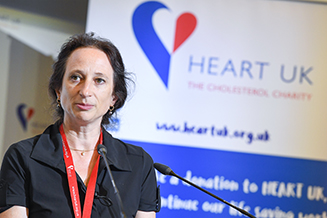HEART UK held its 37th Annual Medical and Scientific Conference between 10th–12th July. This year, the cholesterol charity took on an international theme, looking at the global cardiovascular disease (CVD) prevention picture. There was also a particular focus on women and CVD disease, alongside a review of how familial hypercholesterolaemia (FH) care has advanced in recent decades.
International perspectives in CVD prevention
 |
 |
 |
Professor Kornelia Kotseva (London, UK) discussed the INTERASPIRE study findings, an international survey of 14 countries from each of the six World Health Organization (WHO) regions, designed to provide insights on guideline implementation in those with recent coronary heart disease (CHD), to inform preventive cardiology.1 Poor achievement of lifestyle and medical risk factor targets in secondary prevention patients was observed. High levels of physical inactivity and obesity were found in addition to a lack of combination lipid-lowering therapy and clinical inertia in medication up-titration. These findings highlight how such issues are a global problem and are in no way unique to the UK.
Understanding the NICE and ESC guideline differences
Professor Riyaz Patel (London, UK) detailed the rationale behind the recent change in the secondary prevention target within the latest National Institute of Health and Care Excellence (NICE) CVD risk assessment and reduction guidance.2 He outlined how, when treating the population as a whole, the increased treatment threshold to low-density lipoprotein (LDL) cholesterol level ≤2.0 mmol/L (from <1.8 mmol/L) is primarily derived from cost-effectiveness. This is a divergence to international guidelines, such as the 2019 European Society of Cardiology (ESC) and European Atherosclerosis Society (EAS) which recommend a treatment target of an LDL cholesterol level of <1.4 mmol/L. However, NICE guidelines combine clinical efficacy and value for money, which accounts for this difference.3 Beyond this population-wide health economic decision, however, he stated that this guideline change does not contradict the argument for ‘the lower the better’ with respect to LDL cholesterol, especially in those at higher risk for recurrent CVD.
Women and CVD
Professor Jeanine Roeters van Lennep (Rotterdam, The Netherlands) started this informative and important session by pointing out that atherosclerotic CVD (ASCVD) is the leading cause of death in women. Despite progress over the last 30 years, ASCVD mortality in both sexes is now increasing, with the fastest relative increase occurring in middle-aged women.4
Examples of contributors to this sex difference:4
- Delays in diagnosis and undertreatment in women
- Hormonal effects, such as menopause, which accelerates CVD risk
- Sex differences in lipid metabolism e.g. higher lipoprotein(a) concentration during pregnancy and menopause
- Non-obstructive coronary artery disease and microvascular dysfunction.
Professor Roeters van Lennep’s talk clearly emphasised the need for us to all work together towards addressing this sex inequality with respect to CVD.
Professor Peter Collins (London, UK) followed by reiterating that microvascular coronary dysfunction is much more common in women, especially those who are post-menopausal.5 Professor Collins went on to make the important point that 30% of all stable angina patients have microvascular dysfunction, which is often overlooked once significant large vessel stenosis is excluded.6
More needs to be done to ensure this female-predominant microvascular dysfunction is appropriately identified to ensure that disabling symptoms are not ignored and so that patients can receive tailored therapy, including robust CVD risk factor management.
Prof Collins also highlighted that premature menopause (under 40 years of age) doubles CVD risk.7
Paediatric familial hypercholesterolaemia

Miss Nichola Cowie (Sheffield, UK) outlined how homozygous FH (HoFH) is the most clinically severe form of FH involving two disease-causing mutations and, if untreated, can lead to myocardial infarction (MI) from a young age. Although rare, HoFH patients have profoundly increased levels of circulating LDL cholesterol from birth.8 Paediatric FH care has evolved markedly in recent years.
Nichola presented a case of paediatric HoFH which clearly portrayed the complexity and intensive resource requirements of this severe cholesterol disorder. Key messages from her talk included the need for early multidisciplinary team (MDT) involvement, involvement of the patient and family throughout the decision-making process, as well as the importance of seeking support from specialist centres. Weekly or fortnightly lipoprotein apheresis can be used to remove LDL cholesterol from the circulation; however, the impact of this on the patient and family is considerable.
Keynote Myant lecture: an international perspective on models of care for FH

The prestigious Myant lecture this year was given by Professor Gerald Watts (Perth, Australia). Those attending this year’s conference were treated to a captivating review of the current state of play in global FH care from a world-renowned leader within the FH and lipid realm.
FH is one of the most common inherited conditions and affects around 1 in every 250 people.9 Professor Watts started his talk with a look back at the first lipid clinic, led by the late Dr Nick Myant at the Hammersmith Hospital in the 1960s. He then detailed the gradual evolution of FH care over the last few decades, pointing out that in terms of absolute numbers, Asia has by far the most FH cases worldwide, owing to its huge population. For optimal FH care to be achieved, key pillars should be followed, such as adopting an MDT approach (including primary care), high-quality registries, genetic testing and the application of evidence-based guidelines.
Through extensive worldwide collaborations, Professor Watts has published guidance on how to achieve optimal detection, diagnosis, assessment and management of FH.10 What became clear from his talk was that we already have the tools necessary to advance FH care, such as advanced therapeutics and genetic testing, but we are yet to apply these in a robust manner. A key take-home message from his talk was that in FH we must strive for ‘earlier, lower and longer’ with respect to identification, treatment level and duration. He went on to conclude with suggesting that “we are at the end of the beginning, rather than the beginning of the end” with respect to achieving optimal care for those with FH, highlighting the need for a concerted effort to advance FH care in the decades ahead.
Dr Andreas Tridimas
HEART UK conference organising committee member www.heartuk.org.uk/conference; Consultant in Chemical Pathology and Metabolic Medicine
Countess of Chester Hospital and Wirral University Teaching Hospital, UK
a.tridimas@nhs.net
References
1. McEvoy JW, Jennings C, Kotseva K et al. INTERASPIRE: an international survey of coronary patients; their cardiometabolic, renal and biomarker status; and the quality of preventive care delivered in all WHO regions: in partnership with the World Heart Federation, European Society of Cardiology, Asia Pacific Society of Cardiology, InterAmerican Society of Cardiology, and PanAfrican Society of Cardiology. Curr Cardiol Rep 2021;23(10):136. https://doi.org/10.1007/s11886-021-01568-2
2. Cardiovascular disease: risk assessment and reduction, including lipid modification. NICE guideline [NG238]. December 2023. Available at: https://www.nice.org.uk/guidance/ng238 (accessed October 2024)
3. Mach F, Baigent C, Catapano AL et al. 2019 ESC/EAS guidelines for the management of dyslipidaemias: lipid modification to reduce cardiovascular risk: the task force for the management of dyslipidaemias of the European Society of Cardiology (ESC) and European Atherosclerosis Society (EAS). Eur Heart J 2020;41(1):111–88. https://doi.org/10.1093/eurheartj/ehz455
4. Roeters van Lennep JE, Tokgözoğlu LS, Badimon L et al. Women, lipids, and atherosclerotic cardiovascular disease: a call to action from the European Atherosclerosis Society. Eur Heart J 2023;44(39):4157–73. https://doi.org/10.1093/eurheartj/ehad472
5. Maas AHEM, Rosano G, Cifkova R et al. Cardiovascular health after menopause transition, pregnancy disorders, and other gynaecologic conditions: a consensus document from European cardiologists, gynaecologists, and endocrinologists. Eur Heart J 2021;42(10):967–84. https://doi.org/10.1093/eurheartj/ehaa1044
6. Marinescu MA, Löffler AI, Ouellette M et al. Coronary microvascular dysfunction, microvascular angina, and treatment strategies. JACC Cardiovasc Imaging 2015;8(2):210–20. https://doi.org/10.1016/j.jcmg.2014.12.008
7. Bernhardt L, Lawson CA. Early menopause and risk of cardiovascular disease: an issue for young women. Lancet Public Health 2019;4(11):e539–e40. https://doi.org/10.1016/S2468-2667(19)30184-7
8. Gu J, Gupta RN, Cheng HK et al. Current treatments for the management of homozygous familial hypercholesterolaemia: a systematic review and commentary. Eur J Prev Cardiol 2024;zwae144. https://doi.org/10.1093/eurjpc/zwae144
9. British Heart Foundation. Familial hypercholesterolaemia. Available at: https://www.bhf.org.uk/informationsupport/conditions/familial-hypercholesterolaemia (accessed October 2024)
10. Watts GF, Gidding SS, Hegele RA et al. International Atherosclerosis Society guidance for implementing best practice in the care of familial hypercholesterolaemia. Nat Rev Cardiol 2023;20(12):845–69. https://doi.org/10.1038/s41569-023-00892-0
